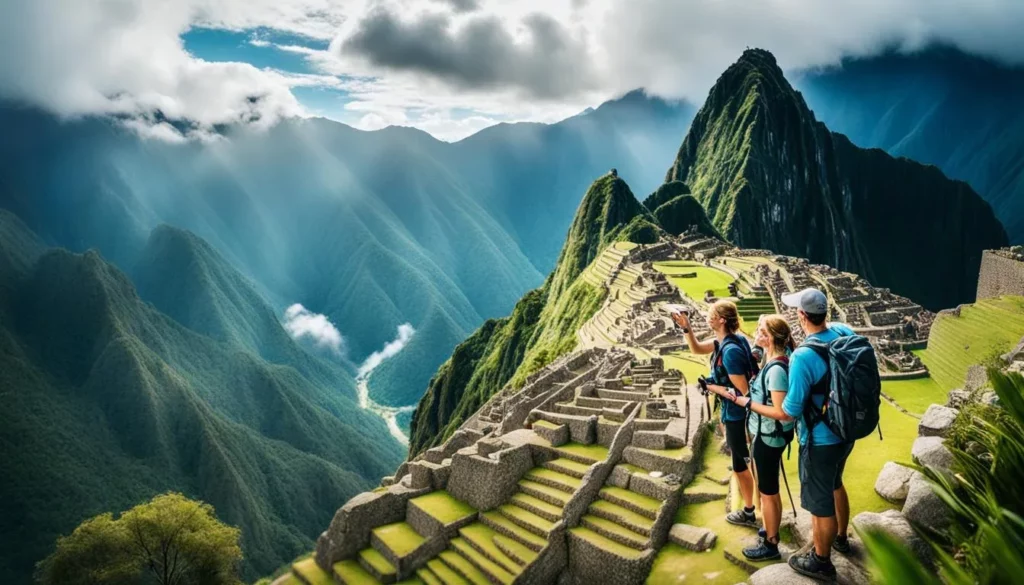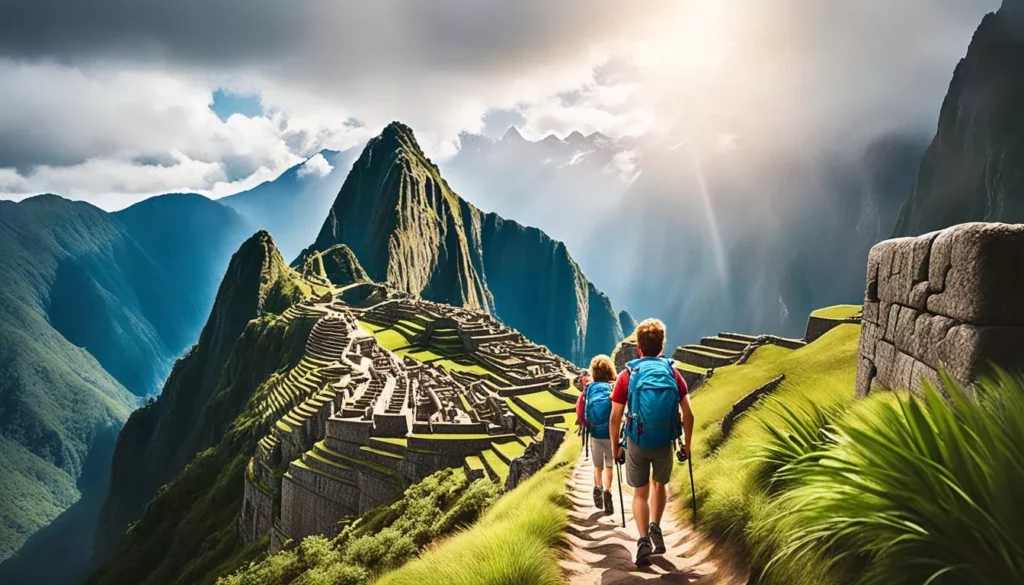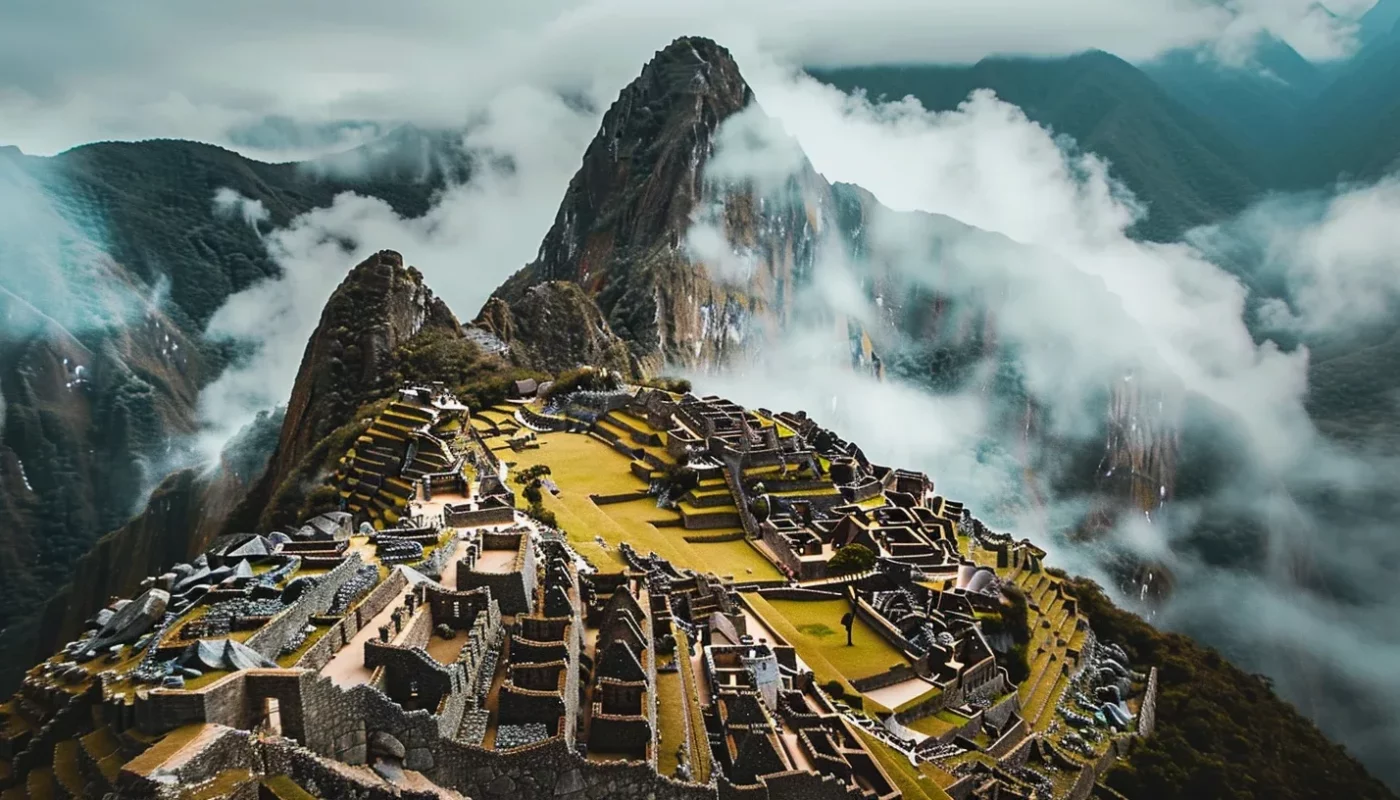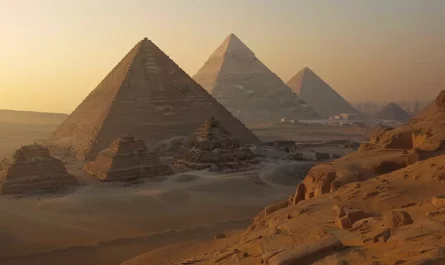Machu Picchu sits 7,900 feet high in the Peruvian Andes and covers 116 square miles. This ancient city has stood strong through earthquakes for over 500 years. It showcases the Inca civilization’s amazing building skills. About 500 stone structures here are built without mortar, yet they’ve lasted for centuries.
Its ancient ruins and legends fascinate many explorers. This place isn’t just an old site; it’s a symbol of Inca heritage, filled with stories and puzzles that still amaze people today.
Protecting Machu Picchu is essential. There are programs to keep it safe from nature and humans. These efforts help keep its history and culture alive for others to see in the future.
Introduction to Machu Picchu
Machu Picchu is a crown jewel in Peruvian history. This amazing archaeological site has caught the attention of many worldwide. It has helped us learn more about the Inca civilization.
Machu Picchu showcases the vast Inca Empire, which spread across today’s several countries from Cusco. The city shows off the advanced building skills of the Incas. Their constructions still stand in a region known for earthquakes, showing their genius.
“Machu Picchu is more than a historical site; it is a triumph of human ingenuity.”
Finding Machu Picchu’s secrets has opened up parts of Peruvian history. Each study on Machu Picchu uncovers more about this great culture. It also highlights efforts to keep this heritage safe for the future.
Working together to conserve Machu Picchu ensures the beauty of the Andes is preserved. It lets everyone continue to explore and learn from Machu Picchu’s legacy.
The Historical Significance of Machu Picchu
Exploring Machu Picchu reveals the depth of the Inca civilization. This ancient wonder highlights the Inca empire’s vast reach across South America. Cusco was its heart, showcasing the civilization’s advanced nature through historical sites.
Inca Civilization
The Inca civilization was among the most developed in pre-Columbian America. Its strategic and complex designs reflect architectural skill. Research shows their sustainable farming and ecosystem management, astonishing historians and archaeologists.
Cusco’s historical sites demonstrate the empire’s greatness and advanced infrastructure.
UNESCO World Heritage Site
Machu Picchu is recognized as a UNESCO World Heritage Site for its cultural and historical value. This status emphasizes the importance of preservation. It shows the dedication to saving its legacy for future generations.
It has been a pilgrimage site for Incan nobility, showcasing deep spiritual and cultural values.
Preserving Machu Picchu means protecting it against natural and human threats. These efforts help keep it as a lasting symbol of the Inca empire’s legacy and its UNESCO status.
Geographical Marvel: The Andes Mountains
The Andes Mountains add to the beauty of Machu Picchu. The Andes Mountains geography creates a dramatic setting for the ancient city. It shows a beautiful mix of nature and human work.
Walking the Inca trails offers views of Andean scenic views that change from green forests to big mountains. These trails were carefully made for great views and to reach Machu Picchu well. They let travelers see Machu Picchu and its area in a unique way.
The layout of Machu Picchu shows how the Incas built with the mountains and valleys in mind. The farming terraces on the mountainside show their smart farming on tough lands.
Saving this place is crucial. Keeping the natural and made parts of this World Heritage site safe is needed. This will keep the special connection between the Andes and Machu Picchu alive for others to see.
| Aspect | Details |
|---|---|
| Elevation | Approximately 7,900 feet above sea level |
| Geographical Location | Andes Mountains |
| Trail Network | Inca Trails |
| Scenic Views | Andean panoramas, cloud forests, and mountain passes |
| Topographical Adaptations | Agricultural terraces, strategic trail placement |
Architectural Wonders of the Inca Civilization
The amazing Inca structures at Machu Picchu show us the brilliance of an ancient world. What makes these constructions special is their creation without modern tools. They didn’t use wheels, iron tools, or animals.
Inca engineering was ahead of its time, especially seen at this site. Foundational work and drainage systems lie below. These hidden parts support the visible wonders, showing how precise the Incas were. The perfectly fitting stones and their unique shapes made the buildings not only beautiful but also strong against earthquakes.
“The precision of Inca stonework remains unparalleled, each stone fitting perfectly with the next, creating a seamless and resilient structure.”
Preserving these Inca achievements is vital. Continuous efforts help keep the ancient city for those who come after us. This includes taking care of the stones and the hidden systems that hold the city up.
| Feature | Description |
|---|---|
| Structural Design | Trapezoidal doors and windows enhance earthquake resistance. |
| Material | Precisely cut stones interlock without mortar. |
| Subterranean Engineering | Drainage systems prevent water accumulation, protecting foundations. |
Unsolved Mysteries of Machu Picchu
Machu Picchu isn’t just known for its stunning views and old ruins. It’s wrapped in many unsolved mysteries. How it was built, how it withstands earthquakes, and the true lost city spark great interest. These mysteries add to the wonder of this ancient Incan site.
The Real Construction is Underground
Machu Picchu has some hidden secrets underground. A lot of the city’s foundations are beneath the surface. This underground work helps keep the city stable and strong. It shows just how skilled Incan builders were, making it last and resist earthquakes over the centuries.
Machu Picchu’s Earthquake Resistance
Machu Picchu’s ability to withstand earthquakes is another mystery. Its buildings use interlocking stones and a unique shape for flexibility. When an earthquake hits, the stones move but then settle back. This smart design showcases the Incas’ deep knowledge of earthquakes, keeping their city safe.
The True Lost City of the Incas
The story of lost Incan cities makes Machu Picchu even more mysterious. Many thought Machu Picchu was the Lost City for a long time. But records now show Vilcabamba might be the real Lost City. This discovery opens more doors to learn about Incan history and their other hidden places.
Breathtaking Scenery Along the Inca Trail
The Inca Trail is more than a hike; it’s a journey through history and beauty. It winds through the Andean mountains, leading hikers to the majestic Machu Picchu.

Historical Route Details
The Inca Trail journey can begin in different places, often starting in the Sacred Valley. It moves past ancient Inca ruins and through cloud forests. Originally, it was a path for Inca nobles and pilgrims heading to Machu Picchu, marking it as an important pilgrimage route.
Modern Day Pilgrimage
Nowadays, the scenic Inca routes attract hikers worldwide. They come to see Machu Picchu and enjoy the Andes’ scenic views and biodiversity. Keeping these paths open and beautiful requires hard work and conservation efforts.
To keep the Inca Trail and its surroundings pristine, there are strict rules. These include limiting the number of hikers. Such steps ensure the trail and its historical and natural wonders remain intact, promoting responsible travel.
Cultural Significance and Religious Theories
Machu Picchu is closely tied to the Incas’ love for their gods and the universe’s mysteries. This old city, known as a Huaca (sacred place) and Yachay Wasi (House of Knowledge), had many Inca ceremonial spots. Each spot showed their respect for nature with gods like the Sun, Pachamama, and Wiracocha. They found a delicate balance between nature and their spiritual beliefs.
Theories on Ceremonial Use
Many think Machu Picchu was key for Inca ceremonies, according to Inca ceremonial sites. These places prove Machu Picchu’s holy role, where rituals celebrated nature, sacred rivers, and mountains. The design mirrors Inca views of three worlds: Uku Pacha, Kay Pacha, and Hanan Pacha. It includes natural and sacred spots like the Pacarinas and Huacas.
Religious Structures and Temples
The Temple of the Moon and other sites show how spiritual Machu Picchu was. These temples matched the stars and cosmic patterns, showing the Incas’ advanced star knowledge. They also looked like other old places like Caral. This makes Machu Picchu an important religious and learning center in the Inca world.
The Incas also honored holy animals like the Condor, Puma, and Snake. These animals stood for flight, strength, and fate and were linked to constellations in the sky. This shows their cosmic beliefs. Machu Picchu’s design with the stars highlights its role in both earth and sky worship.
Exploring Machu Picchu’s Iconic Landmarks
Machu Picchu is Peru’s top tourist spot, known for its stunning landmarks. Sites like the Intihuatana, Temple of the Condor, and Temple of the Sun attract many visitors yearly. These landmarks reveal the Incas’ architectural skills and their deep knowledge of astronomy and spirituality.
Intihuatana (Hitching Post of the Sun)
The Intihuatana is a key feature of Machu Picchu. It’s often thought to be a sundial, but it was more likely used for astronomy. The Incas used it to predict solstices, showing its importance in their ceremonies. Placed perfectly at Machu Picchu, it offers a stunning view of the mountains, highlighting the Incas’ bond with the sky.
Temple of the Condor
The Temple of the Condor showcases a massive condor’s head carving. Historians believe the site likely served as a sacrificial altar. It highlights Inca religious practices and their respect for animals. The intricate architecture of the Condor Temple displays the Incas’ skill and commitment to their ceremonies.
Temple of the Sun
The Temple of the Sun at Machu Picchu stands out with its unique round shape. While it’s not open to visitors, it’s thought to have been important for both astronomy and religion. Positioned to catch the first solstice sunrays, it shows the Incas’ advanced knowledge of the stars. Below it, the Royal Tomb, with its detailed carvings, provides insights into Incan burial rites.
The landmarks at Machu Picchu offer a deep dive into Incan history and culture. They not only help us learn about the Inca civilization but stress the need to preserve such sites. Thanks to ongoing conservation, future generations can appreciate these incredible examples of Incan engineering and spiritual practices.
Machu Picchu: Child-Friendly Exploration Tips
Exploring Machu Picchu’s ruins is thrilling for families. Family travel to Machu Picchu mixes learning with fun for kids. It offers ways to engage them with its history and beauty.
Fun Facts and Engaging Stories
Sharing fun facts and stories is a great way to engage children with history. Did you know a young Quechua boy helped discover Machu Picchu in 1911? Such stories can make the site exciting and memorable for kids.
Safe Trails and Routes
When visiting with kids, safety at Machu Picchu is crucial. The site has child-friendly hikes. Trails like the lower terraces and central plaza are easy for kids. They have safety features like railings and signs.
Also, preserving Machu Picchu helps keep it safe and interesting. Taking care of the trails and monitoring visitors help. This way, future generations can enjoy it too.
| Trail | Difficulty Level | Highlights |
|---|---|---|
| Lower Terraces | Easy | Scenic views, safe paths |
| Central Plaza | Easy | Historical structures, wide-open spaces |
| Temple of the Sun | Moderate | Religious significance, Inca architecture |
Guiding kids through family travel to Machu Picchu is special. Using child-friendly hikes and interesting facts makes the trip safe and fun. This creates lasting memories for the whole family.
Tourism in Peru: Visiting Machu Picchu
Peru offers many travel chances for families who love history. A guide for traveling to Machu Picchu with your family gives great tips. It helps make the trip enjoyable for everyone. Peru’s beauty isn’t just in Machu Picchu. The Sacred Valley and other places also offer fun adventures for families.

Travel Tips for Families
Planning a family trip to Peru needs careful thought. It’s important to think about what everyone likes and needs. Some tips include:
- Pre-Planning: Book your tickets early to get the time you want. Check your passports and maybe get travel insurance.
- Acclimatize: Stay a few days in Cusco first to get used to the high altitude.
- Pack Wisely: Bring light clothes, good hiking shoes, sunscreen, and water bottles.
- Engage with Guides: Local guides can tell interesting stories and facts, keeping kids engaged.
- Safety First: Always stay on the paths and watch your kids closely in high places.
Nearby Attractions
The Sacred Valley has lots of cool places near Machu Picchu. Here are some:
| Attraction | Description |
|---|---|
| Ollantaytambo | Amazing Inca ruins with great terraces. |
| Pisac Market | A great place to shop and see local culture. You’ll find handicrafts and tasty foods. |
| Maras Salt Mines | Interesting old salt pans with a beautiful view. |
| Moray Agricultural Terraces | These terraces were likely used by Incas for farming experiments. |
A travel guide for Machu Picchu helps make your family trip rich and fun. Peru’s wide range of activities offers something exciting for everyone. From thrilling adventures to peaceful explorations, your family’s trip to Peru will be one to remember.
In the end, whether you’re hiking in Machu Picchu or learning about local culture, Peru is full of chances for family bonding and adventure.
Conservation Efforts at Machu Picchu
Machu Picchu is globally recognized and needs careful historical conservation work. This helps keep it safe for future generations. Because it is very important culturally and archaeologically, we must protect this site.
Efforts to conserve the site include fixing structures and managing it sustainably. We’re putting in place rules for visitors that are about sustainability in tourism. It’s important that governments, groups, and tourists all help protect Inca heritage.
To preserve Machu Picchu, we limit how many visitors can come in. We’ve set up specific entry points to decrease damage. These steps help keep the site safe while letting people see its beauty and learn its history.
We also focus on teaching the community and getting them involved in Machu Picchu preservation projects. Teaching locals about the value of protecting Inca heritage and getting them involved helps build a culture of care. This respect for the historical site makes a big difference.
The work done to conserve Machu Picchu shows a deep commitment. We’re determined to keep the site’s beauty and value for all to see. This dedication ensures Machu Picchu remains one of the most loved archaeological sites in the world.
Conclusion
Machu Picchu captivates scholars and tourists with its mysterious beauty and complex history. It stands as a symbol of the Inca’s remarkable achievements. Surrounded by the Andes, its incredible construction showcases the Inca civilization’s genius.
This site is more than just beautiful. It connects us to the advanced engineering and rich culture of the past. Each structure at Machu Picchu tells a part of the Inca empire’s story, stirring wonder and curiosity in us all.
It’s vital to keep Machu Picchu safe for the future. Conservation work helps protect this treasure from the wear of time and tourism. These efforts show how much the world values Machu Picchu, as a symbol of historical and cultural marvel.




